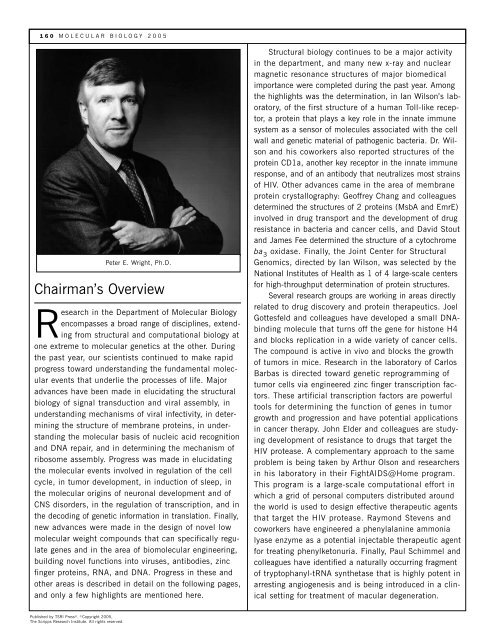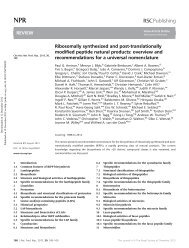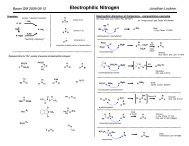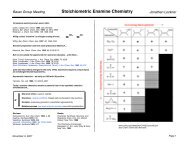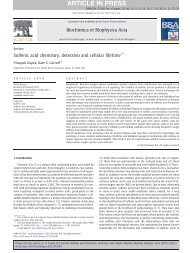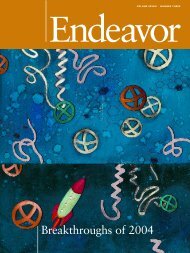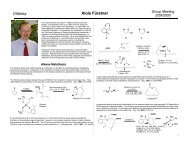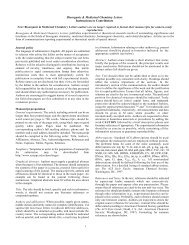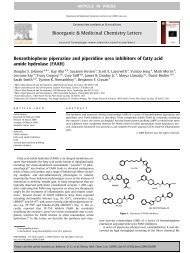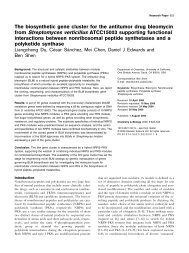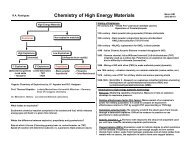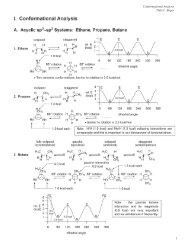Molecular Biology - The Scripps Research Institute
Molecular Biology - The Scripps Research Institute
Molecular Biology - The Scripps Research Institute
Create successful ePaper yourself
Turn your PDF publications into a flip-book with our unique Google optimized e-Paper software.
160 MOLECULAR BIOLOGY 2005<br />
Chairman’s Overview<br />
<strong>Research</strong> in the Department of <strong>Molecular</strong> <strong>Biology</strong><br />
encompasses a broad range of disciplines, extending<br />
from structural and computational biology at<br />
one extreme to molecular genetics at the other. During<br />
the past year, our scientists continued to make rapid<br />
progress toward understanding the fundamental molecular<br />
events that underlie the processes of life. Major<br />
advances have been made in elucidating the structural<br />
biology of signal transduction and viral assembly, in<br />
understanding mechanisms of viral infectivity, in determining<br />
the structure of membrane proteins, in understanding<br />
the molecular basis of nucleic acid recognition<br />
and DNA repair, and in determining the mechanism of<br />
ribosome assembly. Progress was made in elucidating<br />
the molecular events involved in regulation of the cell<br />
cycle, in tumor development, in induction of sleep, in<br />
the molecular origins of neuronal development and of<br />
CNS disorders, in the regulation of transcription, and in<br />
the decoding of genetic information in translation. Finally,<br />
new advances were made in the design of novel low<br />
molecular weight compounds that can specifically regulate<br />
genes and in the area of biomolecular engineering,<br />
building novel functions into viruses, antibodies, zinc<br />
finger proteins, RNA, and DNA. Progress in these and<br />
other areas is described in detail on the following pages,<br />
and only a few highlights are mentioned here.<br />
Published by TSRI Press ®. ©Copyright 2005,<br />
<strong>The</strong> <strong>Scripps</strong> <strong>Research</strong> <strong>Institute</strong>. All rights reserved.<br />
Peter E. Wright, Ph.D.<br />
Structural biology continues to be a major activity<br />
in the department, and many new x-ray and nuclear<br />
magnetic resonance structures of major biomedical<br />
importance were completed during the past year. Among<br />
the highlights was the determination, in Ian Wilson’s laboratory,<br />
of the first structure of a human Toll-like receptor,<br />
a protein that plays a key role in the innate immune<br />
system as a sensor of molecules associated with the cell<br />
wall and genetic material of pathogenic bacteria. Dr. Wilson<br />
and his coworkers also reported structures of the<br />
protein CD1a, another key receptor in the innate immune<br />
response, and of an antibody that neutralizes most strains<br />
of HIV. Other advances came in the area of membrane<br />
protein crystallography: Geoffrey Chang and colleagues<br />
determined the structures of 2 proteins (MsbA and EmrE)<br />
involved in drug transport and the development of drug<br />
resistance in bacteria and cancer cells, and David Stout<br />
and James Fee determined the structure of a cytochrome<br />
ba 3 oxidase. Finally, the Joint Center for Structural<br />
Genomics, directed by Ian Wilson, was selected by the<br />
National <strong>Institute</strong>s of Health as 1 of 4 large-scale centers<br />
for high-throughput determination of protein structures.<br />
Several research groups are working in areas directly<br />
related to drug discovery and protein therapeutics. Joel<br />
Gottesfeld and colleagues have developed a small DNAbinding<br />
molecule that turns off the gene for histone H4<br />
and blocks replication in a wide variety of cancer cells.<br />
<strong>The</strong> compound is active in vivo and blocks the growth<br />
of tumors in mice. <strong>Research</strong> in the laboratory of Carlos<br />
Barbas is directed toward genetic reprogramming of<br />
tumor cells via engineered zinc finger transcription factors.<br />
<strong>The</strong>se artificial transcription factors are powerful<br />
tools for determining the function of genes in tumor<br />
growth and progression and have potential applications<br />
in cancer therapy. John Elder and colleagues are studying<br />
development of resistance to drugs that target the<br />
HIV protease. A complementary approach to the same<br />
problem is being taken by Arthur Olson and researchers<br />
in his laboratory in their FightAIDS@Home program.<br />
This program is a large-scale computational effort in<br />
which a grid of personal computers distributed around<br />
the world is used to design effective therapeutic agents<br />
that target the HIV protease. Raymond Stevens and<br />
coworkers have engineered a phenylalanine ammonia<br />
lyase enzyme as a potential injectable therapeutic agent<br />
for treating phenylketonuria. Finally, Paul Schimmel and<br />
colleagues have identified a naturally occurring fragment<br />
of tryptophanyl-tRNA synthetase that is highly potent in<br />
arresting angiogenesis and is being introduced in a clinical<br />
setting for treatment of macular degeneration.


